This season’s FA Cup Final was played between Liverpool and Chelsea. The sides met again already in the EFL Cup Final three months ago. Thomas Tuchel and Jürgen Klopp would be very familiar with each other as this was their fourth meeting this season and with third in this calendar year. Despite the Reds being the stronger side and arriving with a better squad availability, Chelsea put in a strong effort with good tactics and fighting spirit in this game.
This analysis would break down the flow of the game and explain all the small details of both head coaches.
Lineups
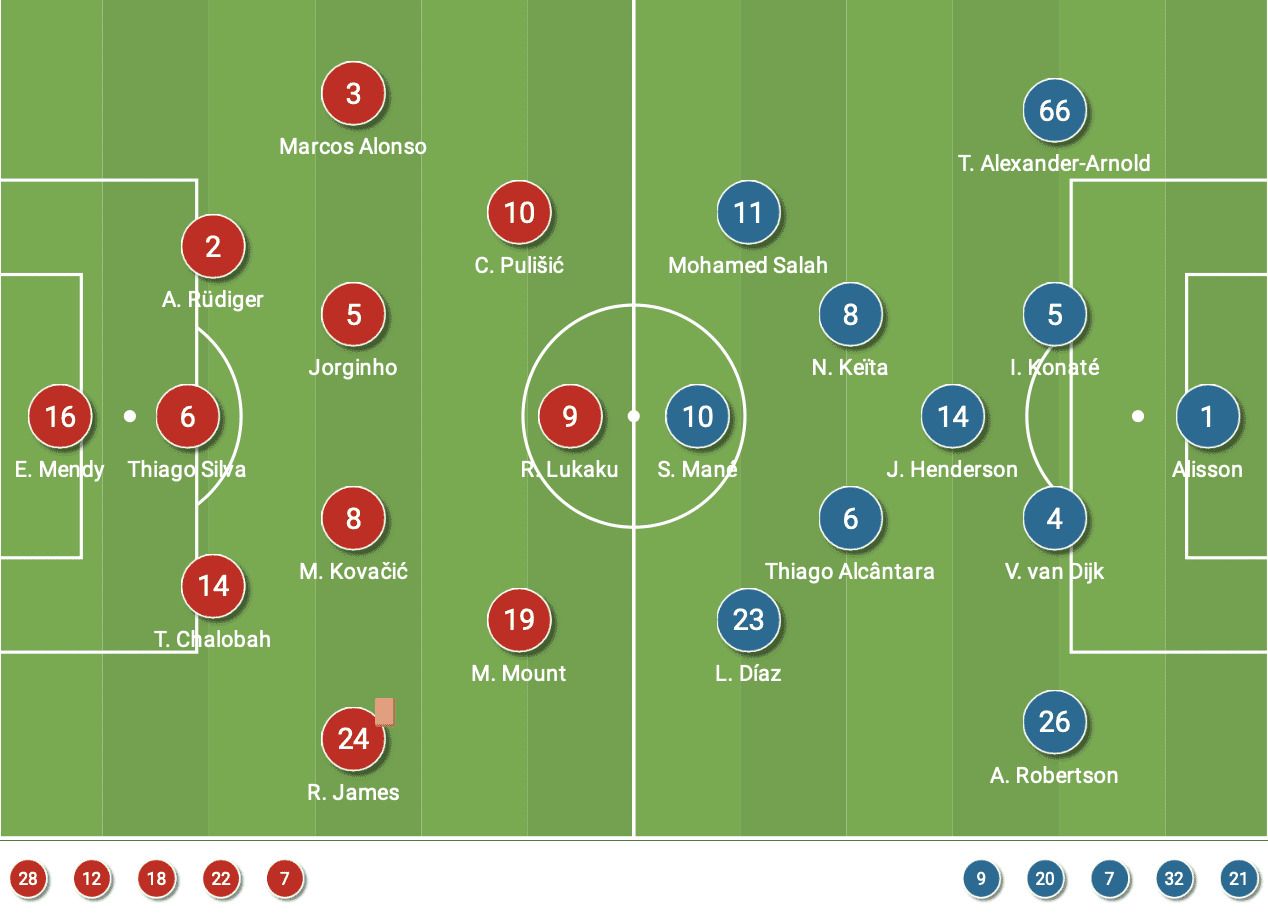
Chelsea had good players but their availability were affected by fitness, as Thiago Silva carried small problems to play the game, while Timo Werner was unable to play despite being in the match squad. Worse still, Kai Havertz was ruled out before the game and Tuchel chose Romelu Lukaku, Christian Pulisic, and Mason Mount as his front three.
Liverpool also had Fabinho injured, and despite Mohamed Salah starting the game, he stepped off in the 33rd min. But the Reds have still got the best players in Europe – even though Joël Matip started on the bench, the partnership between Ibrahima Konaté and Virgil van Dijk was so solid and such a great wall in front of Alisson.
Liverpool had a strong start
The start of Liverpool was very strong. Tuchel himself admitted the first 15 mins were the most difficult period of the game, which they also knew in a part of the game, they would suffer. In the beginning, Liverpool dominated and arrived in the Chelsea third with good conditions when they had the ball.
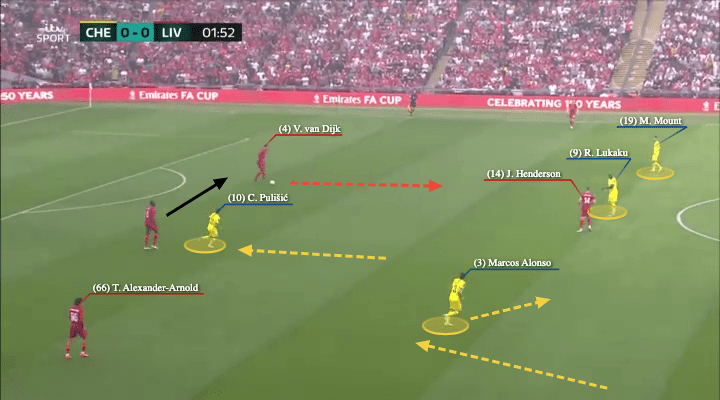
Firstly, we need to look at how Chelsea defended without the ball. They played with a 5-2-2-1 or 5-2-3 in this game but the individual roles were the most important in this phase, as they wanted Lukaku to stay around Jordan Henderson to prevent a pass going into the centre in the initial passes.
When it came to pressing, Chelsea did that in an asymmetrical manner as Marcos Alonso always pushed higher and more often than the right wing-back. We guess the reason for this arrangement would be limiting Trent Alexander-Arnold’s time and space on the ball as soon as he received because he is an incredible passer who could do harm with the long passes. In the front three, Pulisic would also push Konaté but only with the aim of forcing Liverpool to play, not going the way to chase the ball to press the other centre-back laterally, as that would be the role of the other side as shown in the above image.
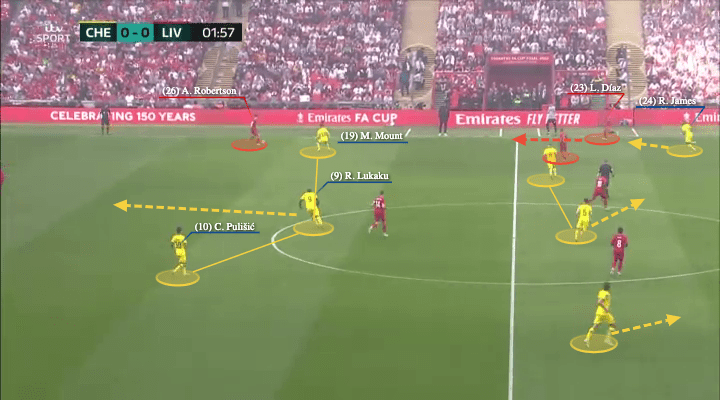
The scene continued with the above screenshot, when van Dijk carried the ball forward, because of Mount’s defensive positioning to block the half-space, he was invited to go outside to find the left-back. Then, Mount would jump to press Andrew Robertson with a straight run, while Lukaku, at that stage, would also jump onto the centre-back to cut the passing lane, so theoretically Liverpool were forced to play in a quicker rhythm, and they should be unable to keep the ball in a very long sequence.
Luis Díaz would drop out to receive very often, in this part of the defending, James must be very careful on the Liverpool left-winger’s movement. If he was too tight, Díaz might have used some double-movements or feints to get behind, so it was not a tight man-marking as they could afford Díaz playing outside of the block.
Then, some usual and basic stuff was demonstrated as well. The Chelsea block swung from one side to the other with the far side players – Jorginho and Alonso moving back to provide the cover.
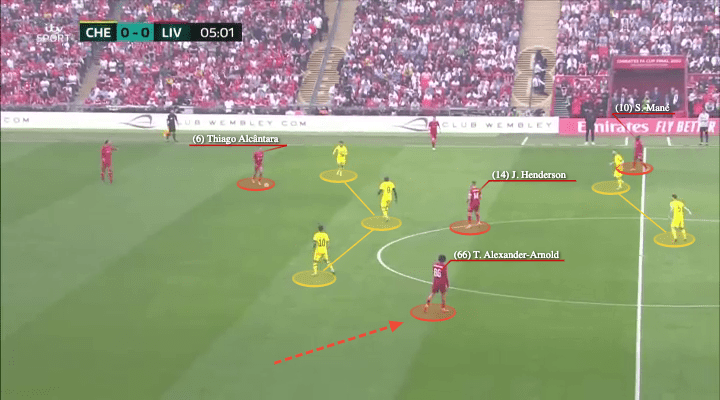
But Liverpool got the midfield control with a pretty smart and flexible structure. Even though Lukaku would limit Henderson’s impact, and so the Chelsea 6 could match Naby Keïta and Thiago Alcântara numerically, the Reds always added in the fourth player to create that “+1” advantage. The best part of this was the way they executed the idea, as the extra player could be Alexander-Arnold as shown above, or Sadio Mané dropping from the striker position.
Then, Liverpool also involved some midfield rotations to create a staggered structure. Henderson did not always have to receive as Thiago could have some freedom to drop out deep when Mané or Alexander-Arnold took infield position. Then, it would be difficult for Chelsea to stop Thiago as no one was close to him, the wingers were more orienting themselves to the full-backs while the 6 would be reluctant to step up from the midfield.
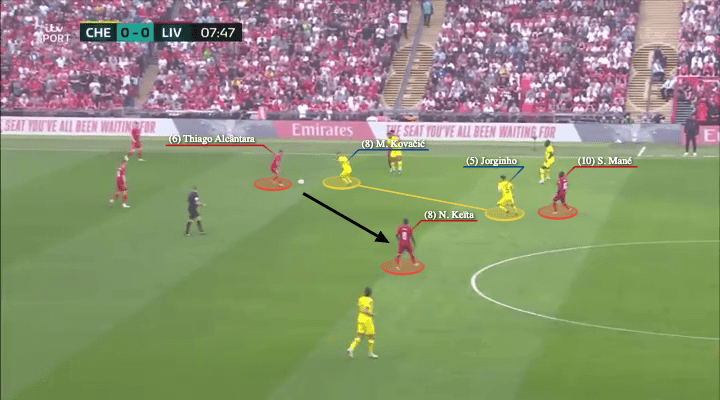
In the midfield, there were a lot of good plays from Liverpool, and a lot of vertical third-man were involved alongside quick passing to break lines in a high tempo. Even though we were taking out Henderson in the above image, with Mané’s presence, the Reds would still be able to generate an extra man as a passing option, which was Keïta in this case.
Also, you could see how the position after rotations of Liverpool players dislocated the Chelsea 6 – when Thiago received in deep and Mané showed up behind him, Jorginho was forced to cover his partner and the diagonal zone was opened for Keïta to receive here.
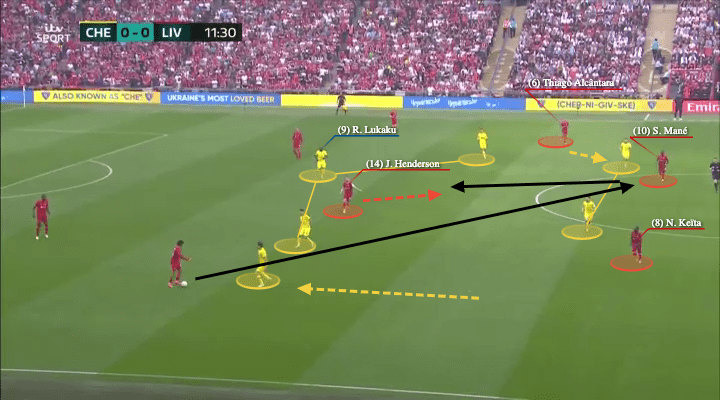
The next example, as shown in the above image, was a vertical third-man passing route. We explained Lukaku’s role and his timing to step up to press the centre-back, but that also means when Liverpool were moving the ball, eventually, Henderson would be free between the lines here.
This time, we also saw Alonso moving up to press Trent Alexander-Arnold but he was too late to close the angle. Then, you could see how the Chelsea two-man midfield line was being exposed to the three staggered Liverpool players in spaces – 3v2 with Thiago, Mané, and Keïta against Mateo Kovačić and Jorginho. This was a sequence in which Kovačić was dragged wide by Thiago and was late on Mané, so it was difficult to stop the first and second passes.
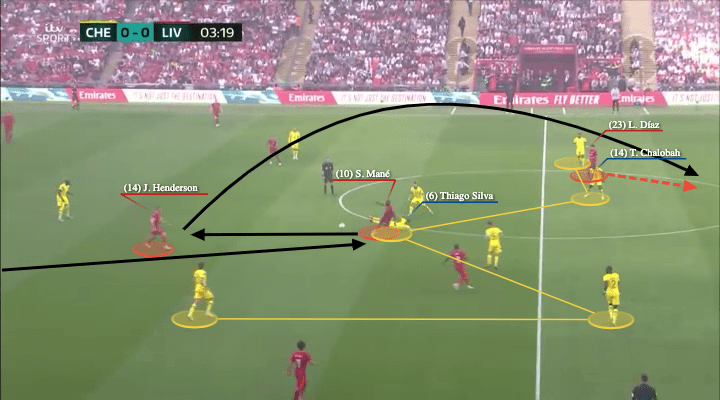
Again, we saw a very similar way of Liverpool’s attack with the vertical third man in the above image, but what if the Chelsea centre-backs came out to stop the striker? Liverpool also had clear solutions for that particular situation, as Díaz was always very high and being ready to go behind in such a case. Liverpool got some early final third entries or even threats from Díaz, and this was the reason.
Here, Silva stayed tight and followed Mané to the midfield but that exposed Trevoh Chalobah in the high line. And the third-man of Liverpool, which was usually Henderson, would always be looking for that diagonal run of Díaz behind the defence and send long balls to exploit that.
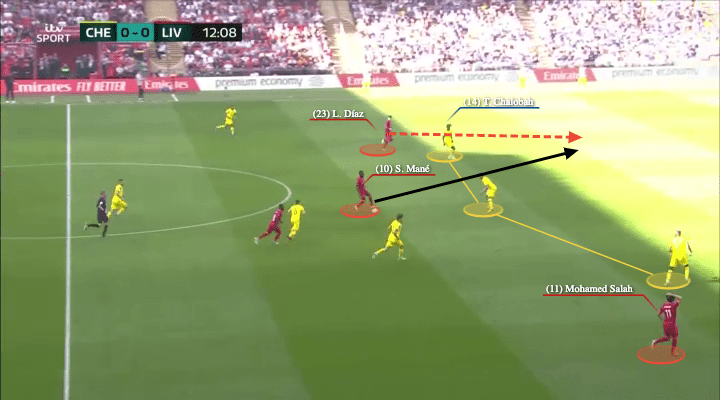
Such a scenario was also worrying for Chelsea in the transitions, as Reece James might be going high in the attack, when they lost the ball in the midfield, Chalobah would be exposed in TAD and Liverpool capitalized on that situation for a couple of times as well.
As shown in the above image, the dilemma of Silva to the Chelsea last line, was that they were unable to catch the quick movements of Mané. That means the Chelsea defenders were unable to stop him from receiving, and the worst case was Mané turning and facing the goal, and as shown now Silva was forced to engage in the above screenshot, and as a result, Chalobah was isolated against Díaz’s run, then you know what was going to happen, slice that ball forward!
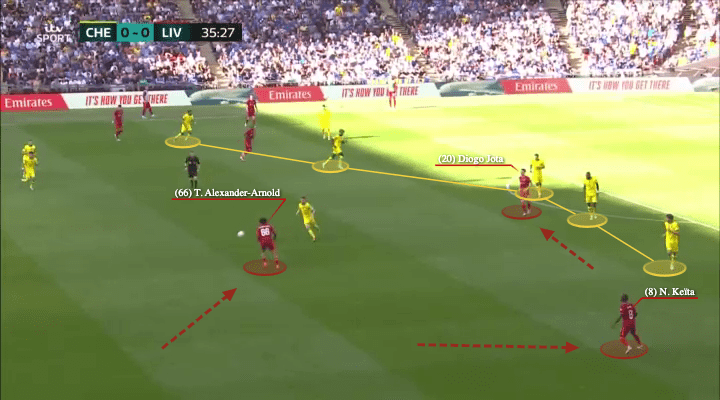
In addition, Liverpool’s structure also involved some positional interchanges between the right side 8, winger, and the right-back, the three players could move to take each other’s position, depending on the situation. The most important was to have players in the positions to be ready for the ball.
For example, Diogo Jota might be closer to the penalty box as he joined an attacking event in the penalty box initially, and so Keïta moved out wider to provide some width. And so, Alexander-Arnold moved in to play in that 8 role, and that’s why the midfield structure of Liverpool could be fluid as explained previously.
Chelsea’s structure tested the opponent
But Chelsea, despite the start was so tough, did not give up easily. Instead, the players quickly picked up the rhythm and cleared their minds to follow the game plan, the structure with the ball was more obvious and that helped them to create chances as well. If you looked at the xG after 120 mins, the Blues were even better than the opponent with 1.93 against Liverpool’s 1.75.
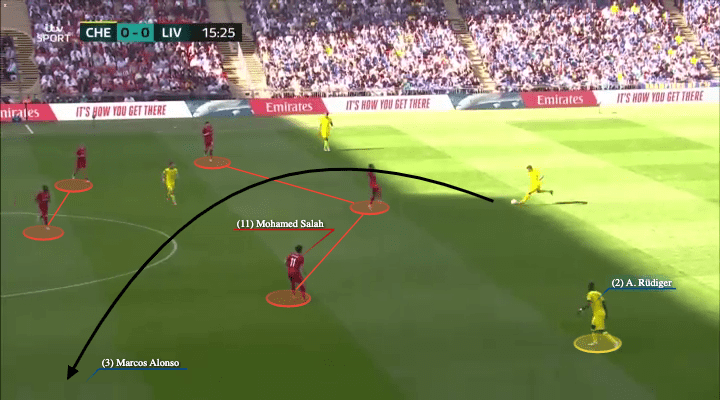
The Chelsea structure was very useful against Liverpool’s 4-1-2-3 pressing as they had a 3-2 in the construction, with two midfielders attracting the Liverpool 8 out. Also, there was a back three to create enough depth (and width if necessary) in the build-up, so they always tried to attract the Liverpool wingers out with the wide centre-backs. For example, Salah above would be trying to catch the pass to Antonio Rüdiger.
And so, Chelsea would use the wing-backs in higher and wider positions as the Liverpool wingers were invited to stay higher. Silva did a very fine job at dictating plays with the ball at his feet and playing these diagonal passes, as shown above, these sequences often reached spaces behind the Liverpool wingers with one pass and the attack would be on there.
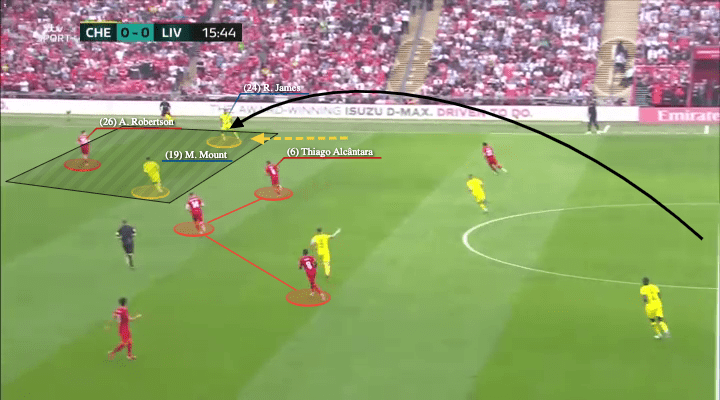
In better scenarios, that wing-back high position should also be able to pair up their half-winger to create 2v1 on the Liverpool full-backs. As shown above, this time, the pass was to the right side to James, and in the highlighted region, Robertson was isolated against two players. As he moved out to close James, Mount would be free to make the half-space forward run, and Liverpool must react to van Dijk’s defending as Henderson’s position was often high to support the press, the Liverpool skipper was easily eliminated by those diagonal passes.
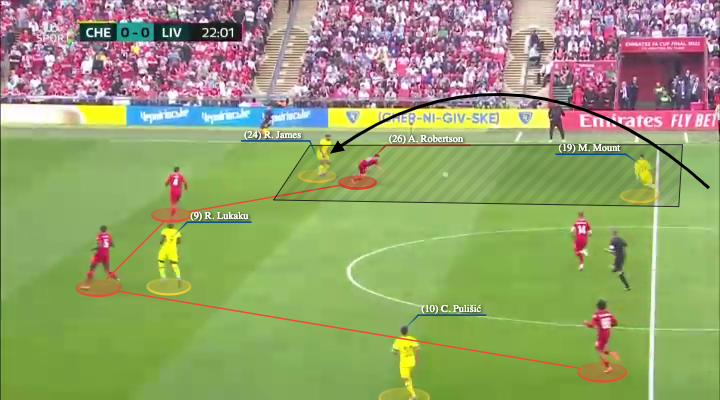
The Alonso chance was definitely attributed to this Chelsea structure. As shown in the above image, it came from a diagonal ball from the Chelsea defender to James, as Robertson did finely to win the first ball. But, the Reds could not pick up the second ball for two reasons. Firstly, Thiago was high to press the Chelsea 6, so he was not in a position for that. And secondly, Mount was exactly in that space, so now a Chelsea attack was on and Liverpool’s last line was very disorganized.
Another impressive part of Chelsea’s game was the involvement of the far side players. Tuchel knew that the Liverpool pressing was very fierce and he did not want the players being isolated, and also, to play out from the pressing zone of the opponent, the far side players must be able to support in diagonal or lateral angles to the wide player on the ball. Or, in this case, Pulisic and Lukaku must be ready to arrive as the first Chelsea pass could always trigger something.
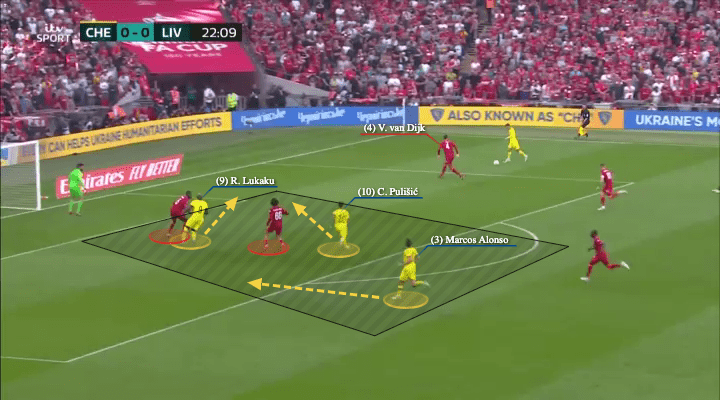
And here came the good chance with Chelsea’s far side players arriving early, they just simply outran Liverpool to make it happen. Van Dijk was forced to engage Mount as a result of Robertson being taken out by James, and also because of Henderson’s initially high position, there were only two Liverpool defenders remaining inside the penalty zone. But there were three Chelsea players! Alonso arrived and now he found himself free on the far side, simple 3v2.
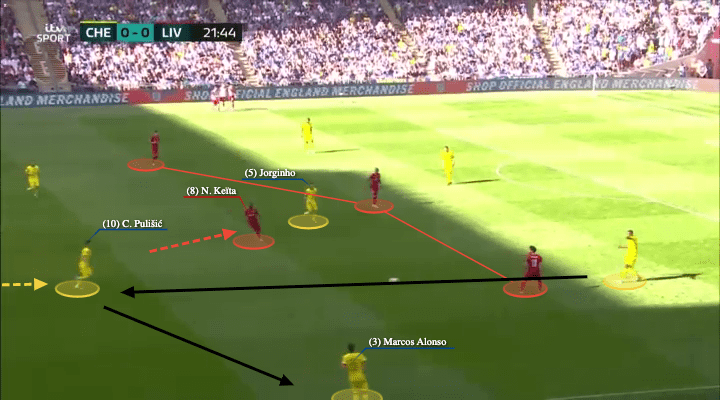
The above image showed Chelsea’s good structure in the construction, which was the one we explained how their 3-2 plus half-wingers created good conditions for a shorter passing game. The point is to invite the 8 or the Liverpool 4-1-2-3 to press, such as Keïta pressing Jorginho here. Then, the Chelsea wingers should present themselves in half-spaces as solutions to use those spaces behind the 8. Can Henderson be very quick to catch all these Pulisic (or Mount) movements? No, he could not because that was too much ground to travel.
With that vertical third-man and good use of space behind Keïta, Alonso was found and now Chelsea could go again with the wing-backs. As Salah was pressing Rüdiger initially, the Liverpool right-winger could not catch the Chelsea wing-back.
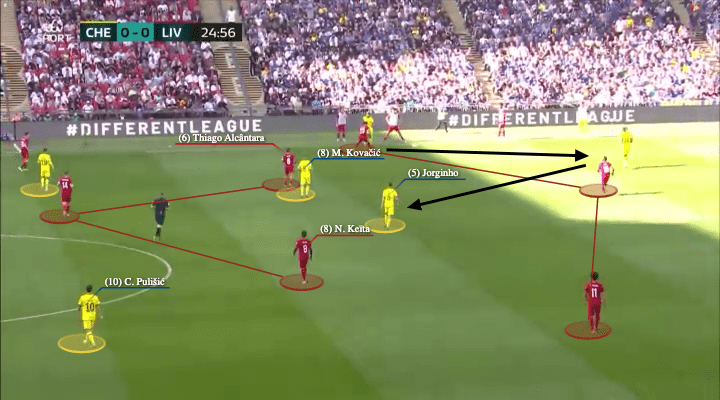
And the position of Pulisic as a half-winger could also create conditions for his 6 to receive as well, as Liverpool would have suffered a 3v4 in the midfield when the Chelsea wingers were playing infield as 10s. The above image was exactly that situation, Pulisic was there to make Keïta hold his position, and with Kovačić occupying Thiago, Jorginho was able to receive between the lines to play.
When Chelsea were able to establish that structure and execute the tactics of Tuchel, they looked much better in possession and it turned out to help the defending a bit, as Liverpool could not win the ball back as easy as they did in the first 15 mins.
Delay, patient, compact
In the above analysis, both sides showed great execution when they have the ball, and clearly, they created as there were weaknesses exposed when each other were without the ball. This was a final, of course, it has to be more cautious than reckless. Hence, both Chelsea and Liverpool adjusted their system without the ball a bit to prevent themselves from being exposed, so the core idea of their defence in the second half would be as described in the subheading – DELAY, BEING PATIENT, AND COMPACT.
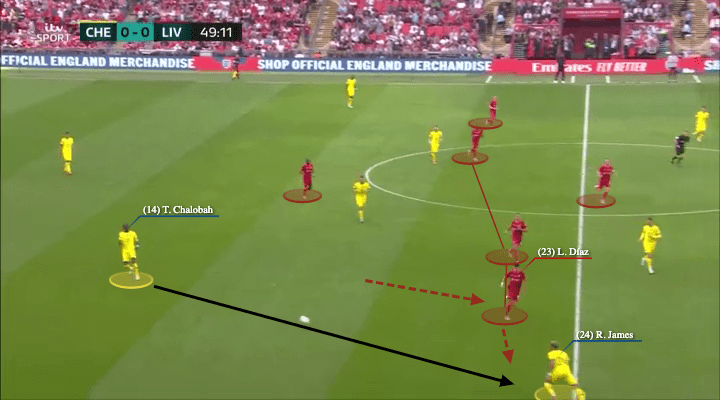
Firstly, from Liverpool’s perspective, at the beginning of the second half, they were no longer a 4-1-2-3 as the position of wingers was too high. Hence, Klopp changed his side to a 4-1-4-1 midblock as shown above, and the difference was the winger was not pushing in the same line with Mané. Instead, they allowed Chalobah some room to play given that he could not do much harm with the ball.
When the pass went to the Chelsea wing-back, the Liverpool wingers must be reacting instantly to close them as Díaz did here, so that James could not easily combine with Mount to threaten Robertson.
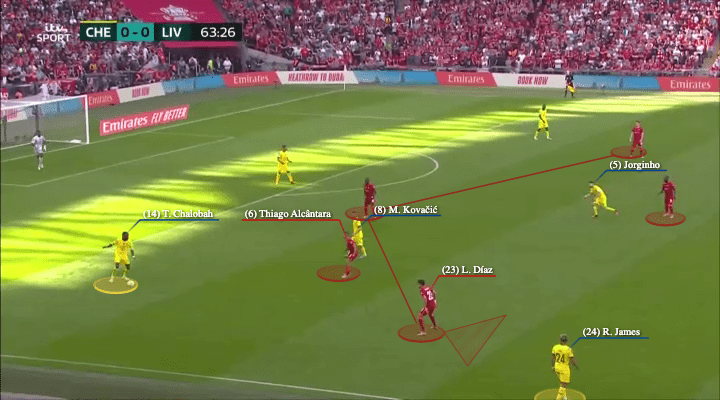
So, the reason for Liverpool lowering the engagement line was not being afraid of pressing, they were just trying to do it better with better strategies, creating optimal conditions to net the opponent while fixing the issues in the backline.
Here, you could see Liverpool might look like a 4-1-2-3 in a similar way in the first half, but if you took a second glance at the winger’s position, it was very different as Díaz intentionally dropped back to limit James’ space – he would not be paralleling with Mané. And so Chalobah found himself difficult to play forward given both Chelsea 6s were tightly marked as well, he chose to go back to Édouard Mendy.
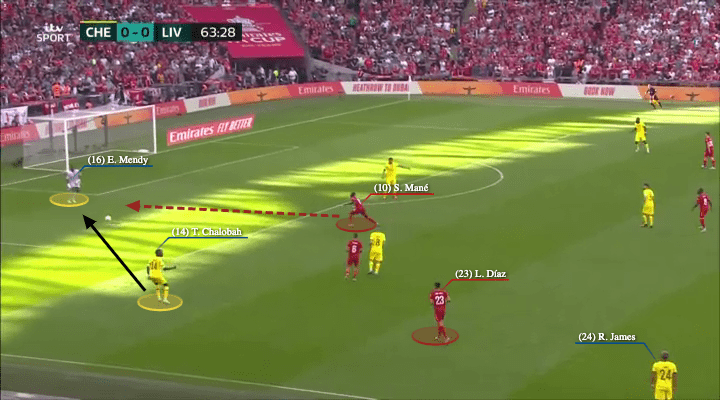
But Liverpool saw that and expected that, it was a pressing trap! Before Mendy received, Mané would already be jumping out to press vertically to catch the goalkeeper, that was with real intention to regain the ball and that’s why the play was speeded up.
And you could also observe Díaz’s position, he was deep enough to catch James if the diagonal pass went to the outside, so it would not be the same 1v2 on Robertson compared to those situations in the first half.
Hence, it was a trap that guide Mendy going back to Chalobah, as Liverpool were leaving that option open.
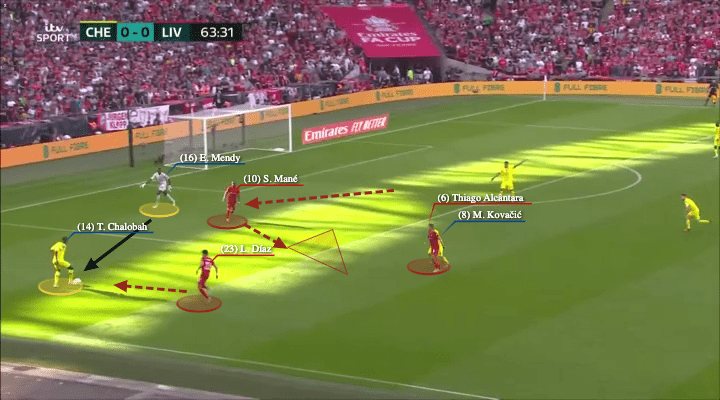
Now you could not play. As long as Díaz saw the pass to Chalobah, he sprinted to push and forced Chalobah to play under pressure. The Chelsea defender kicked the ball away and Liverpool won the ball back eventually.
But that was also attributed to the concerted efforts of other Reds too, as Thiago was still tightly on Kovačić to close the Chelsea 6. Meanwhile, Mané did not stop after pressing Mendy, he immediately moved back to close the passing lane in the centre, so Chalobah could not go to Silva with a ground pass and all short passing options were killed.
With this example, you could see how good was Liverpool’s defending without the ball, everyone knew what they were required to do. So you don’t see Mané chasing the pass to Chalobah or Thiago reckless giving up Kovačić just to press the defender. A textbook pressing trap here, indeed.
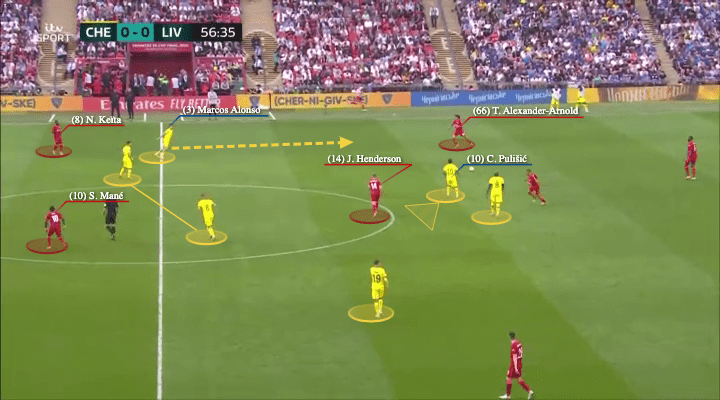
From Chelsea’s perspective, without the ball, they were also changing the defending a bit and being more disciplined, to achieve better compactness without the ball. Here, you could see Lukaku no longer stay with the Liverpool 6, and the Chelsea wingers now stepped down a bit to let the Liverpool centre-backs carry the ball forward. In fact, it was not really a 5-2-3 shape, and more like a 5-2-2-1 with the wingers as 10 to close space and the Henderson in the centre.
Despite Alonso still pressing the right-back, you could also tell his awareness of the player behind, as they knew Keïta would fancy some interchanges with Jota to use that space between the lines. The Chelsea players were communicating a lot more to handle those situations in the second half, as Jorginho shuffled across to cover.
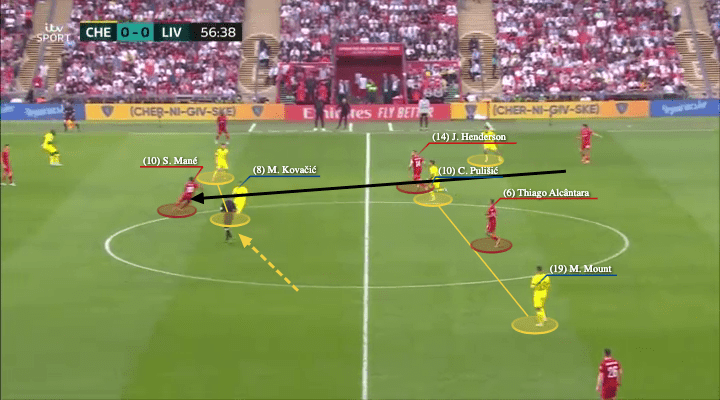
Are there options to pass? Yes, as Alexander-Arnold found Mané with very good passing. But then Chelsea were also able to catch that or even put pressure on the third man, as Kovačić was closer to his partner and Pulisic, who was now the 10 was tighter on Henderson.
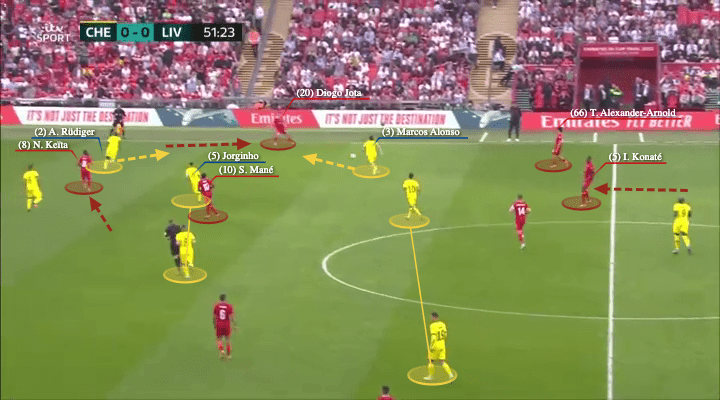
As explained, Liverpool had some tricky positional interchanges on the right side and Chelsea were still able to deal with the initial movements. With the new defensive structure, more yellow shirts were in the centre and the Reds were invited to play outside more often. But because of Alonso’s lower position, the defence was more compact and they were squeezing the middle third areas when Liverpool got there.
Here, Jota came deep to receive, but he triggered the press from Alonso and Rüdiger. To take up Jota’s position, Keïta moved wider but because Chelsea’s lines were more compact, Silva was able to close that option down. And Mané the false-9? No problem, as Jorginho and Kovačić were locking those spaces in the centre now.
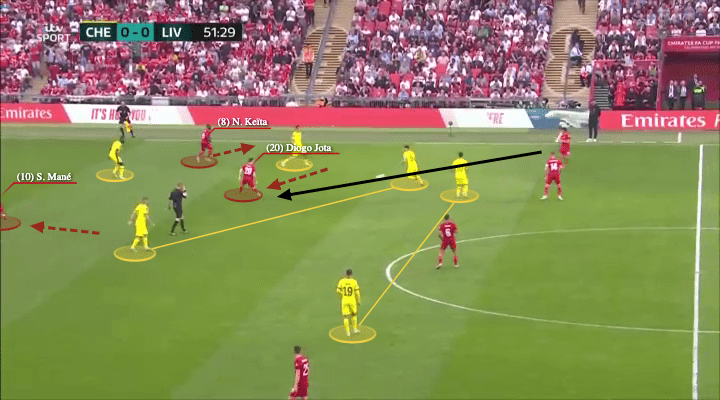
But Liverpool got away with it, and the attack came again. Usually, it was difficult for Chelsea to deal with the post-interchanges moments, transitions, or post-second ball events. You could see how competent were the Reds via this example, as the initial attempt of breaking the lines was not successful, they came again with another interchange – Keïta moving outside and Jota playing in half-space. Then, Mané dashed away from the midfield to become a striker again, these sequence of movement after the initial interchanges would always be more difficult for Chelsea to adapt, and here came Liverpool again.
Conclusion
Chelsea, despite being disturbed by the off-pitch incidents and injuries a lot this season, were able to arrive at two cup finals and kept clean sheets against one of the best sides in the world for 240 mins, which was incredible. Apart from the pre-game designs, as shown in the third part of the tactical analysis, Klopp and Tuchel also demonstrated very good in-game adjustments, which would always be appreciable and valuable for the fans to watch. Now Liverpool already bagged two titles, would the third and fourth ones arrive?





Comments